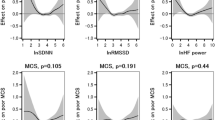Abstract
Objective
To comprehensively evaluate the health status of 6 volunteers from the Mars 500 Project through analyzing their pulse graphs and determining the changes in cardiovascular function, degree of fatigue and autonomic nervous function.
Methods
Six volunteers were recruited; all were male aged 26–38 years (average 31.83±4.96 years). Characteristic parameters reflflecting the status of cardiovascular functions were extracted, which included left ventricular contraction, vascular elasticity and peripheral resistance. The degree of fatigue was determined depending on the difference between the calendar age and biological age, which was calculated through the analysis of blood pressure value and characteristic parameters. Based on the values of pulse height variation and pulse time variation on a 30-s pulse graph, autonomic nervous function was evaluated. All parameters examined were marked on an equilateral polygon to form an irregular polygon of the actual fifigure, then health status was evaluated based on the coverage area of the actual fifigure.
Results
The results demonstrated: (1) volunteers developed weakened pulse power, increased vascular tension and peripheral resistance, and slight decreased ventricular systolic function; (2) the degree of fatigue was basically mild or moderate; and (3) autonomic nervous function was excited but generally balanced.
Conclusions
These volunteers were in the state of sub-health. According to Chinese medicine theories, such symptoms are mainly caused by the weakening of healthy qi, Gan (Liver) failing in free coursing, and disharmony between Gan and Wei (Stomach), which manifests as a weak and string-like pulse.
Similar content being viewed by others
References
Zhang QJ, Bai YQ. Psychological issues in manned space flight. Space Med Med Eng (Chin) 1999;12:144–148.
Alishev NV, Tsygan VN, Drabkin BA, Apchel VIa, Nikolaeva NA, Tarumov AV, et al. Psychoemotional stress and somatic diseases in veterans of special risk units. Adv Gerontol 2008;21:276–285.
Jankosky CJ. Mass casualty in an isolated environment: medical response to a submarine collision. Mil Med 2008;173:734–737.
Dovgusha VV, Myznikov IL, Shalabodov SA, Buma OK. Medical-physiological characteristics of combat training of nuclear-power submarine crews. Voen Med Zh 2009;330:46–53.
Horn WG, Thomas TL, Marino K, Hooper TI. Health experience of 122 submarine crewmembers during a 101-day submergence. Aviat Space Envir Med 2003;74:858–862.
Xu CL, Zhu GJ, Xue QF, Zu SY. Changes of serum thyroid hormone and plasma catecholamine of 16th and 17th Chinese expeditioners in Antarctic environment. Adv Polar Sci (Chin) 2003;14:124–130.
Xu CL, Wang ZH, Li H, Zhang T, Zu SY, Zhu GJ. Changes of biological activity of serum immunosuppressive protein of stress on antarctic winter-over expeditioners. J Toxicol (Chin) 2007;21:392–394.
Xu CL, Chen WN, Chen L, Xue QF, Qi BS, Zhu GJ. The extreme conditions of the Antarctic improves Chinese expeditioners’ lung function. Basic Clin Med (Chin) 2008;28:331–334.
Xu CL, Zu SY, Li XD, Zhu GJ, Xue QF. Changes of serum thyroid hormone and plasma catecholamine of expedition members in Antarctic environment. Chin J Polar Res (Chin) 2001;13:294–300.
Chen FJ, Wang HS, Huang CY, Chen YS. Pulse analysis in bipolar disordered and nonpsychotic human subjects. Am J Chin Med 2012;40:455–465.
Dai J, Sun S, Cao H, Zheng N, Wang W, Gou X, et al. Applications of new technologies and new methods in Zheng differentiation. Evid Based Complement Alternat Med 2012;2012:298014.
Huang CM, Wei CC, Liao YT, Chang HC, Kao ST, Li TC. Developing the effective method of spectral harmonic energy ratio to analyze the arterial pulse spectrum. Evid Based Complement Alternat Med 2011;2011:342462.
Jiang M, Lu C, Zhang C, Yang J, Tan Y, Lu A, et al. Syndrome differentiation in modern research of traditional Chinese medicine. J Ethnopharmacol 2012;140:634–642.
Kim JU, Jeon YJ, Kim YM, Lee HJ, Kim JY. Novel diagnostic model for the deficient and excess pulse qualities. Evid Based Complement Alternat Med 2012;2012:563958.
O’Rourke MF, Pauca A, Jiang XJ. Pulse wave analysis. Br J Clin Pharmacol 2001;51:507–522.
Tang AC, Chung JW, Wong TK. Digitalizing traditional Chinese medicine pulse diagnosis with artificial neural network. Telemed J E Health 2012;18:446–453.
Wang Y, Yu Z, Jiang Y, Liu Y, Chen L, Liu Y. A framework and its empirical study of automatic diagnosis of traditional Chinese medicine utilizing raw free-text clinical records. J Biomed Inf 2012;45:210–223.
Niu X, Yang XZ. Multidimensional pulse diagnostic message collecting and processing system for dynamic identification of radial artery motion. J Beijing Univ Chin Med (Chin) 2005;28:43–46.
Fei ZF. Advances in pulse instrument and thoughts on "Cunkou" pulse condition. Acta Univ Tradit Med Sin Pharmacol Shanghai (Chin) 2012;26:7–10.
Fei ZF, ed. Modern traditional Chinese medicine pulse diagnostics. 1st ed. Beijing: People’s Medical Publishing House;2003:162–165.
Xu JT, Wang QH, Sun HJ, Fei ZF. Investigative analysis of biological age in sphygmogram of healthy group by ZM? intelligent pulse apparatus. Acta Univ Tradit Med Sin Pharmacol Shanghai (Chin) 2000;14:35–36.
Fei ZF. Main physiological indexes and comprehensive imaging evaluation of sub-health state. Acta Univ Tradit Med Sin Pharmacol Shanghai (Chin) 2008;122:6–11.
Jiang L, Shao Y, Zhang XW, Zhang XY, Yong L. Exploratory research on pulse parameters assessment on autonomic nervous function of depression. Chin J Inf Tradit Chin Med (Chin) 2011;18:10–11,105.
Wang LM, Zhao X, Wu XL, Li Y, Yi DH, Cui HT, et al. Diagnosis analysis of 4 TCM patterns in suboptimal health status: a structural equation modeling approach. Evid Based Complement Alternat Med 2012;2012:970985.
Di D, Zhou M, Qin PF, Zhu W. Research progress on objective collection and analytical method of pulse manifestations in traditional Chinese medicine. Shanghai J Tradit Chin Med (Chin) 2014;48:104–108.
Chu GX, Chen QG, Xu JT, Yu B, Zhang M, Cui LT, et al. Analysis on pulse diagram characteristics of subjects with subhealth state. J Chin Integr Med (Chin) 2012;10:1099–1105.
Author information
Authors and Affiliations
Corresponding author
Additional information
Supported by the National Manned Space Flight Engineering Foundation of China and Advance Research Project in Manned Spaceflight of China (No. 010202)
Rights and permissions
About this article
Cite this article
Shi, Hz., Fan, Qc., Gao, Jy. et al. Evaluation of the health status of six volunteers from the Mars 500 project using pulse analysis. Chin. J. Integr. Med. 23, 574–580 (2017). https://doi.org/10.1007/s11655-016-2539-5
Received:
Published:
Issue Date:
DOI: https://doi.org/10.1007/s11655-016-2539-5




